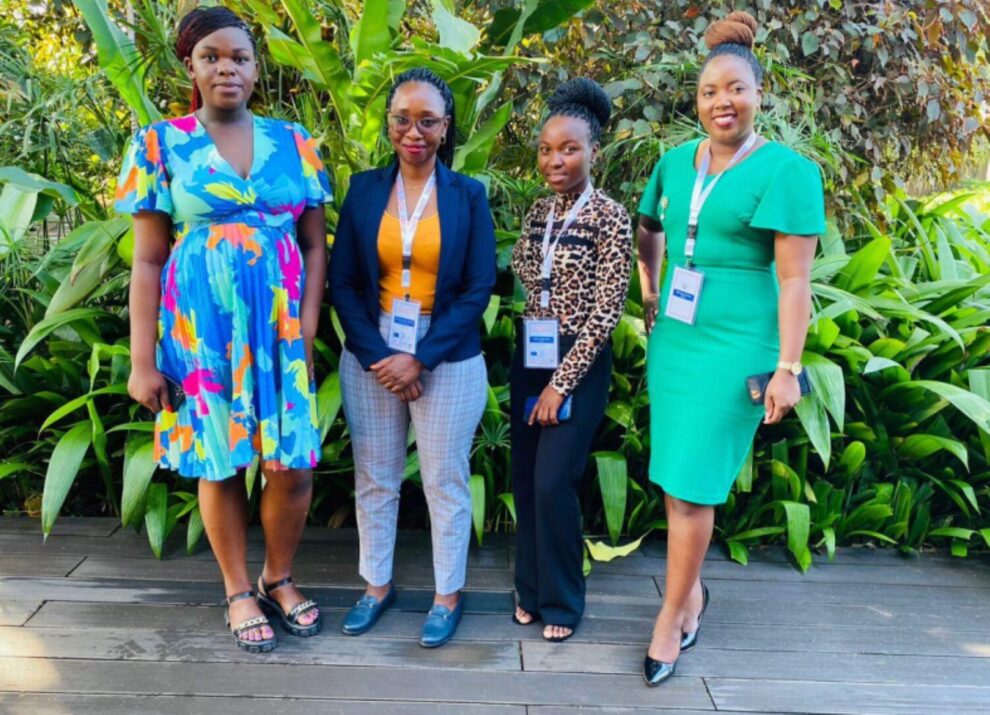This article was originally published on the AfricaConnect3 website.
Kusha, an innovative ICT solution aimed at empowering researchers in Eastern and Southern Africa by leveraging the power of social media to promote their research findings to a wider audience. It came to light at the Women Hackathon which was co-funded by the European Union under the AfricaConnect3 project and held alongside UbuntuNet-Connect 2023 conference. The women hackathon was the first of its kind in the region, bringing together 15 young women 5 different universities in 5 different countries in the UbuntuNet Alliance region. The event is part of the commitment that UbuntuNet Alliance has to empower women in STEM in the region under the AfricaConnect3 project. Six months since the historic event, the journey for one of the teams, Kasha and its developers, continues to unfold. This article takes a look into their progress.
The term “Kusha” translates to “disseminate” in Shona (a bantu language), reflecting the core objective of this system to disseminate research in an accessible manner. Kusha serves as a comprehensive platform that allows researchers to seamlessly link their research journal links from research platforms to Kusha. By integrating advanced technologies, Kusha enables researchers to generate journal summaries, policy briefs, and infographics automatically from their research, ensuring better accessibility and comprehension for a non-specialist audience. Additionally, the system harnesses Generative Pre-trained Transformers to provide researchers to generate multiple options for social media post drafts, catering to popular platforms like Instagram, X ( formally Twitter), and LinkedIn. Kusha also allows researchers to link their social media usernames to the system, facilitating direct posting and real-time interaction with their audience.
The Developers
Kusha was developed by a team of four young ladies from Africa University in Zimbabwe: Yollanda Yeukayi Washaya, Blessing Gavaza, Trish Ngazire and Ashley Masvodza.
System Features
- Abstract summarization: The abstract summarization module in Kusha uses Generative Pre-trained Transformer(GPT) which is based on the GPT architecture. Specifically, it’s derived from GPT-3.5, which is a version of the GPT series of models developed by OpenAI. GPT-3.5 is a language generation model trained on a vast amount of text data and is capable of generating human-like text responses. The model is trained on a large dataset of research papers and abstracts, and it is able to identify the main points of a research paper and generate a concise summary that accurately reflects those points to generate a summary of a research paper abstract.
- Image and text generation: The image and text generation module in Kusha uses a trained generative AI model – DALL·E to generate images and text from summaries of research papers. DALL·E is based on a variation of the GPT architecture and is specifically designed for generating images from textual descriptions. It uses a variation of the GPT architecture that has been adapted and trained specifically for this task.
- Social media integration: The social media integration module in Kusha allows users to share their summaries and images directly to social media platforms, such as Twitter, Facebook, and LinkedIn by integrating with social media API’s such as the Facebook Graph API. This makes it easy for researchers to disseminate their research to a wider audience.
Objectives
- To enable researchers to link their research journal links from research platformswith Kusha, streamlining the process of sharing their work on social media.
- To enable researchers to link their research or publish their findings, leveragingautomated processes to generate journal summaries, policy briefs, andinfographics, simplifying complex research for a broader audience.
- To facilitate interaction and engagement between researchers and the largeracademic community.
- To use social media to increase the visibility and impact of research.
- To provide researchers with an easy-to-use platform for sharing and promoting their research findings.
Beneficiaries
Kusha can be used by, but is not limited to, the following beneficiaries.
- Researchers: To increase the reach of their research by disseminating their findingsthrough social media, Kusha allows researchers to connect with a wider audience beyondacademia.
- General public: More accessible research findings will lead to increased publicawareness of scientific advancements and their potential impact on society.
- Policymakers: Easily digestible summaries and policy briefs can inform evidence-basedpolicy decisions.
- Students and educators: Understanding research through summaries and infographicscan benefit students at various levels and educators who can use Kusha as a resource fortheir teaching.
The idea of developing Kusha was sparked by a call for UbuntuNet Alliance First ever Women Hackathon. That was when the team gathered to brainstorm for an idea that would spark the interest of the organizing team. The first concept was developed during the Women HackathonThe Hackathon played a crucial role in the development of Kusha. We got to have hands-on experience on the processes of system development, from the documentation to the final product. The Hackathon also fostered a culture of teamwork and collaborative working environment.After the Hackaton, Kusha gained recognition. Winning the Hackathon brought Kusha some attention, attracting additional support from our institution. Also, we used the prize money from the Hackathon to further develop Kusha into a more functional prototype.
The developers had the following to share
“The idea of developing Kusha was sparked by a call for UbuntuNet Alliance’ First ever Women Hackathon. That was when the team gathered to brainstorm for an idea that would spark the interest of the organizing team. The first concept was developed during the Women Hackathon. The Hackathon played a crucial role in the development of Kusha. We got to have hands-on experience on the processes of system development, from the documentation to the final product. The Hackathon also fostered a culture of teamwork and collaborative working environment. After the Hackaton, Kusha gained recognition. Finishing in the top 3 in the Hackathon brought Kusha some attention, attracting additional support from our institution. Also, we used the prize money from the Hackathon to further develop Kusha into a more functional prototype.”
Challenges faced during the development
The main challenge we faced was limited resources. Developing and maintaining a complex platform like Kusha requires a significant investment in human resources (developers, data scientists) and financial resources (server costs, maintenance). However, as we continue to improve Kusha into something more functional, we will make sure we come up with solutions to overcome these challenges.
Future Plans
- Multilingual support: Kusha is only available in English. So to broaden Kusha’s reach and user base,we plan to expand its language capabilities
- Partnership and integration: Collaborating with academic institutions from all over Africa, research funders, orsocial media platforms could enhance Kusha’s reach and functionality.
- Sustainability Model: The platform will explore a subscription model, partnerships with researchinstitutions, or grant funding to ensure its long-term stability.
Get Involved with Kusha:
- Webinars and Workshops: The Kusha aims to organize online or in-person events demonstrating Kusha’s features and benefits. This allows for direct interaction with the developers to addresses any questions or concerns.
- Partnering with research and education institutions: Kusha is open to collaborate with universities, research centers, or funding agencies to promote research and education. This can be in the form of presentations, workshops at research institutions, and including Kusha in onboarding materials for new researchers.
- Publications: The team will publish research papers or articlesevaluating the platform’s effectiveness in disseminating research findings.
- Maintain a user-friendly platform: The team will ensure Kusha has a clean, intuitive interface and ongoing technical support to address any user issues promptly.
- Integration with existing tools: The team is currently exploring integrating Kusha with existing research management tools or platforms used by researchers, making it a seamless addition to their workflow.







